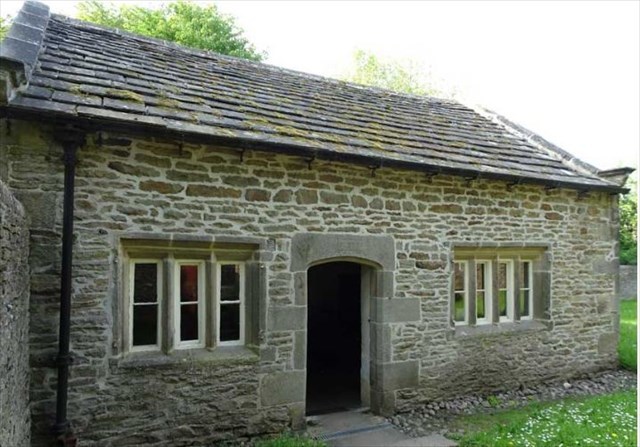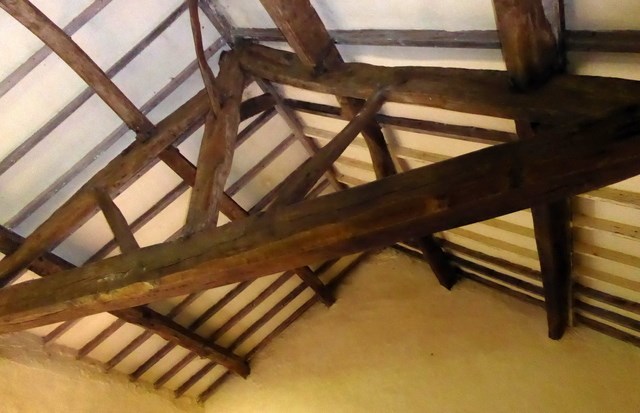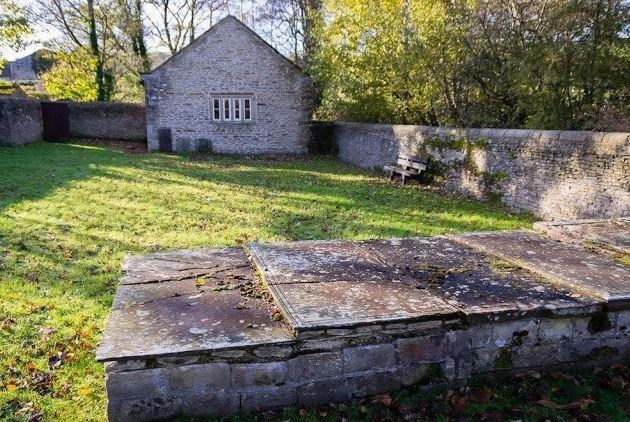Church Micro 12142 . . . Farfield

The cache, a magnetic nano, is hidden at this modest but historically significant place of worship recently chosen by Historic England as one of the 10 Faith and Belief places in their list of ‘A History of England in 100 Places’.
Parking is available for 2 cars at the side of the building. Kindly park so as not to block access to neighbouring houses. The building is open daily during daylight hours.
Step 1: at N 53 57.732 W 1 53.128 there is a wall plaque giving information on the meeting house and George Fox the founder of the Quakers (see here for his autobiography). You will note that the church sits in a burial ground dating from 166A
Update 25/10/21: as this info may now be missing, use the value of A = 6
Step 2: now proceed around the corner to the front gate, to the right of which is a (new) round wall plate recording the fact that this place is specially recognised by Historic England as one 'that tells England's story'. The date shown on this plate is 201B
Step 3: go down the steps and to the door of the meeting house where you will note that the 'star' backing plate for the large door handle has C points
Step 4: enter the simple room and as you look around you will see that there are D pews in the central area (ie. not against the walls)
Step 5: now exit into the small graveyard where @ N 53 57.728 W 1 53.126 you will find E vertical headstones against the east wall of the building
Step 6: move over to N 53 57.734 W 1 53.105 where there are 5 horizontal gravestones covered in lichen and moss. The last one on the right (as you face the building) is inscribed:
J Lister
Died 5th
11th Month
1F5F
The cache is hidden at:
N 53 57.(A+1)(F-D(B-A) W 1 53.C(E+4)

 In 1686 local yeoman farmer Anthony Myers of the nearby Farfield Hall provided a plot of land on a 5,000 year lease to be used as a Quaker burial ground. Three years later in 1689, he gave an adjacent plot of land for building of the Farfield Meeting House - one of the oldest Quaker buildings in existence.
In 1686 local yeoman farmer Anthony Myers of the nearby Farfield Hall provided a plot of land on a 5,000 year lease to be used as a Quaker burial ground. Three years later in 1689, he gave an adjacent plot of land for building of the Farfield Meeting House - one of the oldest Quaker buildings in existence.
Until then Quaker worship was illegal and they often met in the open air so they could deny to anyone who challenged them that they were a meeting for worship. Even so, two London Quakers were imprisoned in 1670 for holding an open air meeting and in Oxfordshire a wealthy Quaker was sentenced to prison for building a small stone meeting house similar to Farfield.
See here for an excellent short video about the Quakers featuring Farfield Meeting House.
The first step towards religious freedom - long taken for granted - was the Toleration Act 1689, when  nonconformist worship was to a limited extent decriminalised. Local Quaker meetings around Addingham were probably already well established in a clandestine way and they prompty built a meeting house at Farfield.
nonconformist worship was to a limited extent decriminalised. Local Quaker meetings around Addingham were probably already well established in a clandestine way and they prompty built a meeting house at Farfield.
Quakers at that time adopted dress, manners and lifestyles of calculated simplicity, and the building is in line with this - a typically modest meeting house constructed in stone rubble with ashlar dressing, with a stone slate roof supported by a single king post truss, and a stone flagged floor. The building is single storey with three bays. There is one door, and the three windows have mullions; at the corners of the building are quoins. The interior consists of a single cell. At its east end is a dais (from where the elected leaders started and closed meetings) with settles and turned ballusters.

It has a small burial ground where most of the over 100 burials are in unmarked graves, as was then Quaker practice. However, there is also a row of five large table-tombs dated between 1687-1737 commemorating the Myers family. It is not known whether or when they became Quakers, but as benefactors they must have been sympathetic at least. Such tombs are exceptionally rare in Quaker burial grounds as this style of memorial was associated with grand - even royal - burials and therefore usually an anathema to Quakers.
 The building was in regular use till around 1816-19 then worship ceased in the 1890s after which it was in agricultural use before becoming an artist's studio in the 1950s and 60s. A special trust, established in 1993 to take into ownership redundant places of worship of outstanding architectural and historic interest, acquired the building in 1994 and has restored the wall stonework and roof. It was later agreed to have the Dales Way diverted a few yards so that it now directly passes the Meeting House and walkers have a safer road-crossing point. Most visitors still come by foot, discovering the Meeting House as a small surprise along the route. Today it is a Grade II* listed building.
The building was in regular use till around 1816-19 then worship ceased in the 1890s after which it was in agricultural use before becoming an artist's studio in the 1950s and 60s. A special trust, established in 1993 to take into ownership redundant places of worship of outstanding architectural and historic interest, acquired the building in 1994 and has restored the wall stonework and roof. It was later agreed to have the Dales Way diverted a few yards so that it now directly passes the Meeting House and walkers have a safer road-crossing point. Most visitors still come by foot, discovering the Meeting House as a small surprise along the route. Today it is a Grade II* listed building.
An interpretation panel on the rear wall facing the Dales Way path - near the cache location - gives the history of the site.
At the time of visiting, an art installation 'There But Not There' had been placed in the meeting house. This  consists of transparent figures, representing soldiers killed in the WW1, a version of which was first shown in Penshurst Church, East Sussex in 2016. A national charity, Remembered, has been set up to encourage the use of the figures to support initiatives and events in November 2018 to mark the end of the war.
consists of transparent figures, representing soldiers killed in the WW1, a version of which was first shown in Penshurst Church, East Sussex in 2016. A national charity, Remembered, has been set up to encourage the use of the figures to support initiatives and events in November 2018 to mark the end of the war.
In October 2018 a meeting will be held to discuss promoting the building as a local amenity so that it again becomes in regular use like similar buildings in Settle and Skipton.
See here for a short video on the meeting house and here for a photo blog.
See here for an informative BBC feature on Quakerism and here for a list of notable Quakers. This includes: James Dean, Richard Nixon, Joan Baez, John Cadbury, David Byrne, Dame Judy Dench, Bonny Raitt, Joseph Lister, Kevin Bacon, Dave Matthews, David Lean, and Ben Kingsley.